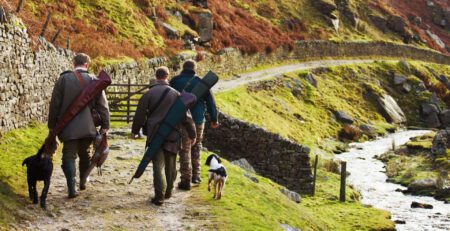CLAY TARGET SHOOTING: OLYMPIC AND SPORTING DISCIPLINES
Clay target shooting, as we know it today, involves several disciplines divided into SPORTING and OLYMPIC shooting.
In our “History of Clay Target Shooting” we explained that, even though shooting sports can be traced back to 1871, when the National Rifle Association of the United States held the first major competitions, it took until 1915 for clay target shooting to enter the scene for the first time in Massachusetts.
The number of different disciplines has changed substantially since then, and you may find it challenging to choose one or the other if you’re new to the sport.
Whether you’re starting from scratch or you’re a hunting enthusiast who wants to practice outside the hunting season, today we’re here to try and lend you a hand with your decision, giving you all the information you need to start out on the right foot.
TYPES OF CLAY TARGET SHOOTING DISCIPLES
Like we said, the different types of clay target are grouped into SPORTING and OLYMPIC disciplines.
The sporting group includes numerous disciplines, including Universal Trench (also known as Universal Trap), DTL (Down the line), Compak Sporting and Hunting Trails among some others.
The Olympic shooting discipline includes Olympic Trap, Double Trap and Skeet.
The difference between them lies mainly in the number of targets thrown, their trajectories and the difficulty and number of opportunities for the shooter.
Let’s take a closer look at each.
SPORTING CLAY TARGET SHOOTING DISCIPLINES
Here we take a look at the Universal Trench (Universal Trap), DTL (Down the line), Compak Sporting and Hunting Trails disciplines.
UNIVERSAL TRENCH

We already took a deep dive into this discipline in our last blog post, “Universal Trench: the sport for the most adventurous clay target shooters”.
To summarise, there are five positions in Universal Trench where shooters try and hit one of the targets thrown from one of a group of five traps installed in a trench.
A computer controls the way the traps release the targets based on one of the 10 official schemes established by the FITASC.
In other words, even though the target trajectories are different from one shooter to the next, all shooters receive the same number of targets at the end of each round.
The Universal Trench championships usually consist of 200 targets/8 heats. That is, each round consists of 25 targets-
Targets that measure 11 cm in diameter, 12-gauge shotguns and cartridges with up to 28 grams of lead are used in this discipline.
It’s one of the events that requires both excellent composure and technique, making it one of the favourites of the most experienced shooters.
DTL (DOWN THE LINE)

DTL is a very popular sport shooting discipline in Australia, New Zealand, South Africa, Zimbabwe, Canada, France, the United Kingdom and Ireland.
It has five shooting stands in the shape of a half moon, positioned 16 yards from the trap machine.
Each shooter takes up one of these firing positions. The shooter in position 1 starts shooting, followed by the shooter in position 2 and so on. When all five shooters have fired five shots on that stand, they move to the next stand “down the line” to their right. The shooter in position number 5 moves to position number 1.
In other words, each shooter will shoot a total of 25 shots, five at each shooting station.
Shooters use a double-barrelled shotgun, generally the ‘over and under’ type, and both barrels are allowed to be fired at a single target released.
COMPAK SPORTING

We also recently discussed this discipline in our blog post about “Compak Sporting: what is it and what are the best targets for practising it?”
In the post we talk about how Compak Sporting is one of the most popular disciplines among hunting enthusiasts who take advantage of the off-season to improve their technique and hone their skills for the next season.
In this form of shooting, the shooter contends with targets with highly varied trajectories, making it one of the most exciting disciplines.
The Compak Sporting range has five traps and five shooting stations where the shooters
stand. The area inside the stand is one metre by one metre and the stands are set up in a line, spaced a few metres apart for safety.
If you’re a hunter, you already have your own shotgun to use for Compak Sporting. If you’re just starting out, the shotgun you should use for this discipline is a 12-gauge shotgun with cartridges of up to 28 grams of lead and a pellet size between 5.7 and 8.
As for the targets, we have several specific models for this discipline: Rabbit, Midi or Mini and Batue or Patena and a great variety of colour clays.
You can see the FITASC competition rules here.
SPORTING
One of the most popular types of shooting in the UK and a favourite with hunters, since it seeks to simulate small game hunting over large areas of land with ravines, vegetation and woodland, which hide the flight of the target from the shooter for enhanced realism and greater difficulty.
There is no exact number of shooting positions (although the positions are fixed), shooters, traps or target trajectories in this discipline. The number will depend on the size of the terrain and the trap machines are positioned based on what the game would be like in that location, the trajectory of the clay target adapted to the type of flight that you want to imitate.
This discipline uses the same shotgun and cartridges as Compak Sporting.
Different sized targets are used, offering a range of speeds and trajectories. You can see our targets for the courses here.
This discipline is also regulated by FITASC.
OLYMPIC CLAY TARGET SHOOTING DISCIPLINES
In this section we’ll take a look at the Olympic Trap, Double Trap and Skeet disciplines.
OLYMPIC TRAP

This is the iconic Olympic shooting discipline.
A total of 15 trap machines are used in this sport, three for each of the five shooting stations.
The shooters compete in squads of six, one shooter per stand plus one on standby, who rotate successively through the five stands.
Five targets are shot from each stand in each of the five rounds, with a total of 125 targets for the men’s category, while in the women’s category a total of 75 targets are shot in three series of 25 each:
- Two to the right, released by the trap on the left.
- Two to the left, released by the trap on the right.
- One central.
The targets used in this discipline are 11 cm, launched at around 120 km/hour and designed to travel up to 80 metres at different heights.
The shooter knows where the target is launched from but not the angle of release, making the shooter’s reflexes, concentration and shooting speed decisive when it comes to hitting the target.
Olympic Trap uses a 12-gauge shotgun and 24-gram cartridges.
Our Green Dream clay is the best clay to be used for this discipline making the shooter reach really high scores who become really satisfied!
This discipline is regulated by the ISSF, the International Shooting Sport Federation.
DOUBLE TRAP

The main characteristic of this Olympic shooting discipline is that the shooter has to shoot at two targets launched at the same time with diverging trajectories.
This means that the shooters’ speed and reaction time are one of the most important factors in performing well in this event.
In this sport, three clay target traps are positioned in a pit in front of the shooting stations. Each trap releases two targets at the same time, which the shooter has to break with two consecutive shots before they hit the ground.
The shooters are positioned in five different spots on the field. A total of 150 targets are shot in five rounds of 30 targets each for the men’s event, while in the women’s event, 120 targets are shot in three rounds of 20 doubles each.
For this event, 12-gauge shotguns and up to 24-gram cartridges are used, while the targets have to be 11 cm in diameter.
SKEET

The discipline was developed in the 1920s by Massachusetts natives Charles Davis and William Harnden Foster, a noted grouse hunter.
Readers of a US shooting magazine voted on the name in 1926 after the magazine offered $100 to anyone who could come up with a name for the sport. “Skeet”, from the Norwegian for “shooting”, won.
It is one of the most specific disciplines in terms of design and rules.
In this sport, the shooter has to complete a course of eight shooting stands arranged in a semi-circle with a radius of 21 yards, where a high and a low trap house are positioned at each end of the course.
Starting with the high house, shooters move through seven positions around the semi-circle, firing a set combination of shots at each stand. Stand number 8 is positioned between the high and low trap houses, and the final shots require the shooter to break a target that is released from each.
As shooters move from one house towards the other, the traps release the targets at a range of angles designed to simulate the shots that upland hunters encounter in the field. The targets are released closer to the shooters and in a wider variety of scenarios.
The targets, 11 centimetres in diameter and with a fixed trajectory and velocity, are fired in five sets of 25 targets each for a total of 125 targets.
The shotgun must be a 12-gauge shotgun fired with 24-gram cartridges.
This discipline is regulated by the ISSF, the International Shooting Sport Federation.
We hope that this brief description of each of the sporting and Olympic clay target shooting disciplines will help you to make up your mind if you still have any questions about which discipline to start out with in this fantastic sport.
If you’ve been practicing the sport for a while, what’s your favourite discipline and how are your results coming along?
Let us know…












